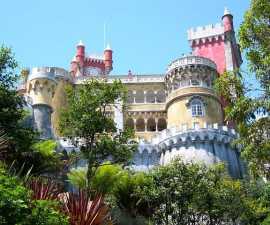Cascais and the surrounding area are full of remnants of a bygone era that mesh perfectly with the modern sophistication that envelops this delightful region just thirty kilometres west of Portugal’s capital city, Lisbon.
There are historic attractions aplenty to be seen during your visit – plan to spend time exploring both the old town of Cascais and the ethereal hill town of Sintra in the mountain range that flanks this section of coastline before dipping down to meet the Atlantic Ocean.
A journey through time and history
Cascais itself was once a sleepy village before being catapaulted to fame thanks to its popularity with the Portuguese kings of the nineteenth century as their summer residence of choice as well as its subsequent patronization by European nobles and their families during the early part of the twentieth Century as they sought refuge from the Second World War in Portugal’s neutral territory. To this day Cascais attracts the great and the good, representing both old money and new, throughout the summer season.
Cascais Old Town dates back to the seventeenth century and boasts several architectural reminders of that seafaring age in its fortresses, lighthouses and Old Town citadel. The Largo de Camões is the town’s central square and a good place to start your explorations of the area. The Largo de Camões is a popular meeting point for locals and tourists alike and has a bustling, lively atmosphere that seems to encapsulate the town’s personality.
Head to the Igreja de Nossa Senhora da Assunção located on another tree-lined square, towards the western end of town. Open daily from 9am – 1pm and from 5pm – 8pm the Igreja de Nossa Senhora da Assunção features a series of paintings in the nave by Josefa de Óbidos, a seventeenth-century artist who is notable for achieving such an artistic pose despite her status as a female. There is an attractive altar dating from the late sixteenth century as well as hand-painted tiles in traditional Portuguese style dating from the early eighteenth century.
Heading out of town along the Avenida Rei Humberto II de Itália is the Museu do Conde de Castro Guimarães, located in the former nineteenth-century home of a well-known local family. The museum offers a window into the lives of eighteenth- and nineteenth-century Portuguese dignitaries, showcasing ceramics, antiques, artworks, silverwares, embroidery and much, much more. The Museu do Conde de Castro Guimarães is open from Tuesday to Sunday from 10am – 12.30pm and from 2pm – 5pm. Guided tours are available and well worth the nominal fee in order to make the most of your trip.
Journey to the magical mountains of Sintra
Leaving Cascais behind and heading into the Sintra mountain range, you soon arrive at the heart of this historical town where palaces and magical architecture are the order of the day. Located right in the centre of town is the Quinta da Regaleira, a large estate built in the early twentieth century to the design of the Italian architect, Luigi Manini, and funded by the millionaire António Augusto Carvalho. The Quinta da Regaleira is a designated UNESCO World Heritage Site for it unique mix of architectural styles, including Gothic, Manueline (Portuguese Renaissance style) and Neoclassical. Wander amongst the tranquil gardens to the accompaniment of the delicate sounds of the water features to transport yourself miles away from the realities of the twenty-first century.
The eighteenth-century Palácio Real de Queluz is one of the most famous and well-preserved examples of European Rococo architecture. This was once the summer residence of King D. Pedro II and Queen Maria I who are largely credited with bringing about Cascais’ popularity amongst the Portuguese and European dignitaries who have favoured the area ever since. The Palácio Real de Queluz is a study in architectural extravagance as in historical significance, packed full of beautiful “azulejos”, the traditional tile work of Portugal, as well as ornate gilding and elaborate accessories and landscaping.
Don’t return to Cascais without visiting the Palácio Nacional de Mafra, the eighteen-century palace-monastery that was built during the reign of King D. João V at Mafra, just a short ride from Sintra. This is one of the most impressive examples of Baroque architecture to be found anywhere on the European mainland and was built in order to demonstrate Portugal’s wealth and success to its European neighbours to the east. The Palácio Nacional de Mafra estate includes a palace, convent and church and boasts a staggering 1200 rooms, 4700 doors and windows and more than 40,000 rare tomes in its library.
